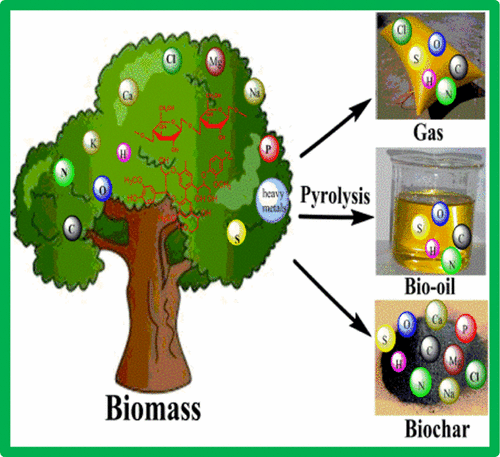当前位置:
X-MOL 学术
›
Chem. Rev.
›
论文详情
Our official English website, www.x-mol.net, welcomes your
feedback! (Note: you will need to create a separate account there.)
Fates of Chemical Elements in Biomass during Its Pyrolysis
Chemical Reviews ( IF 51.4 ) Pub Date : 2017-03-24 00:00:00 , DOI: 10.1021/acs.chemrev.6b00647 Wu-Jun Liu 1 , Wen-Wei Li 1 , Hong Jiang 1 , Han-Qing Yu 1
Chemical Reviews ( IF 51.4 ) Pub Date : 2017-03-24 00:00:00 , DOI: 10.1021/acs.chemrev.6b00647 Wu-Jun Liu 1 , Wen-Wei Li 1 , Hong Jiang 1 , Han-Qing Yu 1
Affiliation

|
Biomass is increasingly perceived as a renewable resource rather than as an organic solid waste today, as it can be converted to various chemicals, biofuels, and solid biochar using modern processes. In the past few years, pyrolysis has attracted growing interest as a promising versatile platform to convert biomass into valuable resources. However, an efficient and selective conversion process is still difficult to be realized due to the complex nature of biomass, which usually makes the products complicated. Furthermore, various contaminants and inorganic elements (e.g., heavy metals, nitrogen, phosphorus, sulfur, and chlorine) embodied in biomass may be transferred into pyrolysis products or released into the environment, arousing environmental pollution concerns. Understanding their behaviors in biomass pyrolysis is essential to optimizing the pyrolysis process for efficient resource recovery and less environmental pollution. However, there is no comprehensive review so far about the fates of chemical elements in biomass during its pyrolysis. Here, we provide a critical review about the fates of main chemical elements (C, H, O, N, P, Cl, S, and metals) in biomass during its pyrolysis. We overview the research advances about the emission, transformation, and distribution of elements in biomass pyrolysis, discuss the present challenges for resource-oriented conversion and pollution abatement, highlight the importance and significance of understanding the fate of elements during pyrolysis, and outlook the future development directions for process control. The review provides useful information for developing sustainable biomass pyrolysis processes with an improved efficiency and selectivity as well as minimized environmental impacts, and encourages more research efforts from the scientific communities of chemistry, the environment, and energy.
中文翻译:

生物质热解过程中化学元素的命运
如今,生物质已被越来越多地视为可再生资源,而不是有机固体废物,因为可以使用现代工艺将其转化为各种化学品,生物燃料和固体生物炭。在过去的几年中,热解作为将生物量转化为有价值的资源的有前途的多功能平台吸引了越来越多的兴趣。然而,由于生物质的复杂性,仍然难以实现有效且选择性的转化过程,这通常会使产物复杂化。此外,生物质中包含的各种污染物和无机元素(例如重金属,氮,磷,硫和氯)可能转移到热解产物中或释放到环境中,引起环境污染问题。了解其在生物质热解中的行为对于优化热解过程以实现有效的资源回收和减少环境污染至关重要。但是,到目前为止,关于生物质热解过程中化学元素的命运尚无全面的综述。在此,我们对生物质热解过程中的主要化学元素(C,H,O,N,P,Cl,S和金属)的命运进行了严格的评论。我们概述了有关生物质热解过程中元素的排放,转化和分布的研究进展,讨论了面向资源的转化和减少污染的当前挑战,强调了理解热解过程中元素的命运的重要性和意义,并展望了未来过程控制的开发方向。
更新日期:2017-03-24
中文翻译:

生物质热解过程中化学元素的命运
如今,生物质已被越来越多地视为可再生资源,而不是有机固体废物,因为可以使用现代工艺将其转化为各种化学品,生物燃料和固体生物炭。在过去的几年中,热解作为将生物量转化为有价值的资源的有前途的多功能平台吸引了越来越多的兴趣。然而,由于生物质的复杂性,仍然难以实现有效且选择性的转化过程,这通常会使产物复杂化。此外,生物质中包含的各种污染物和无机元素(例如重金属,氮,磷,硫和氯)可能转移到热解产物中或释放到环境中,引起环境污染问题。了解其在生物质热解中的行为对于优化热解过程以实现有效的资源回收和减少环境污染至关重要。但是,到目前为止,关于生物质热解过程中化学元素的命运尚无全面的综述。在此,我们对生物质热解过程中的主要化学元素(C,H,O,N,P,Cl,S和金属)的命运进行了严格的评论。我们概述了有关生物质热解过程中元素的排放,转化和分布的研究进展,讨论了面向资源的转化和减少污染的当前挑战,强调了理解热解过程中元素的命运的重要性和意义,并展望了未来过程控制的开发方向。











































 京公网安备 11010802027423号
京公网安备 11010802027423号